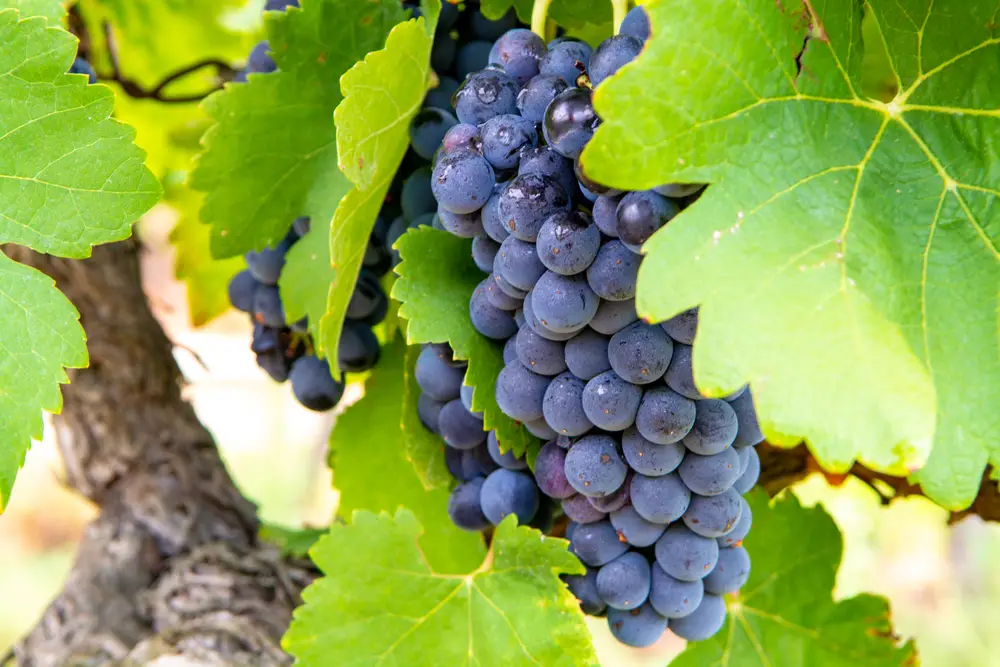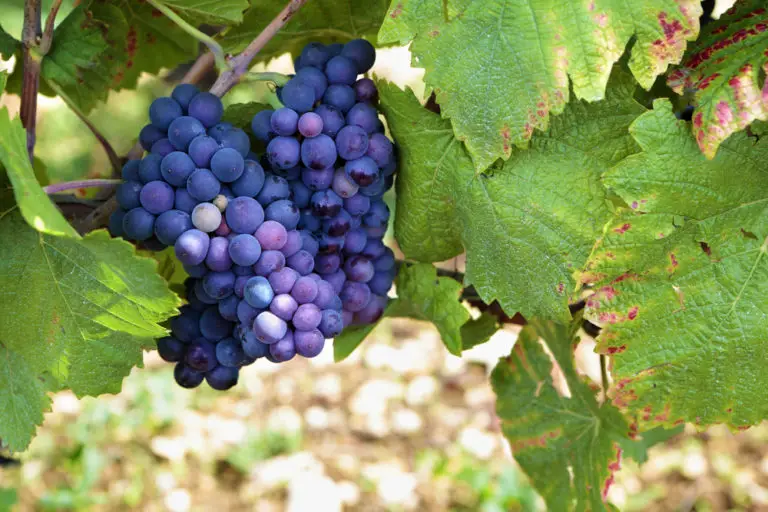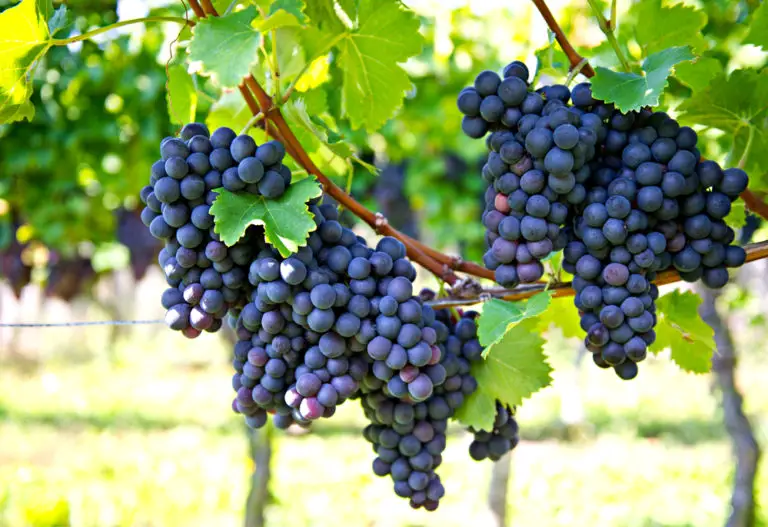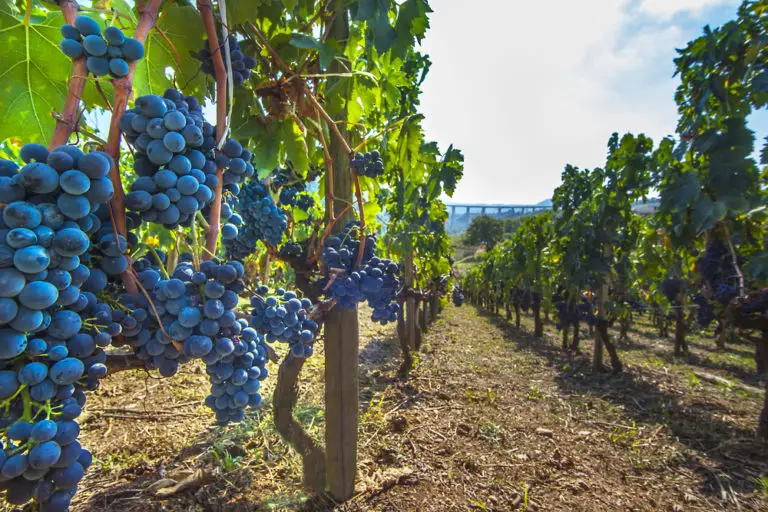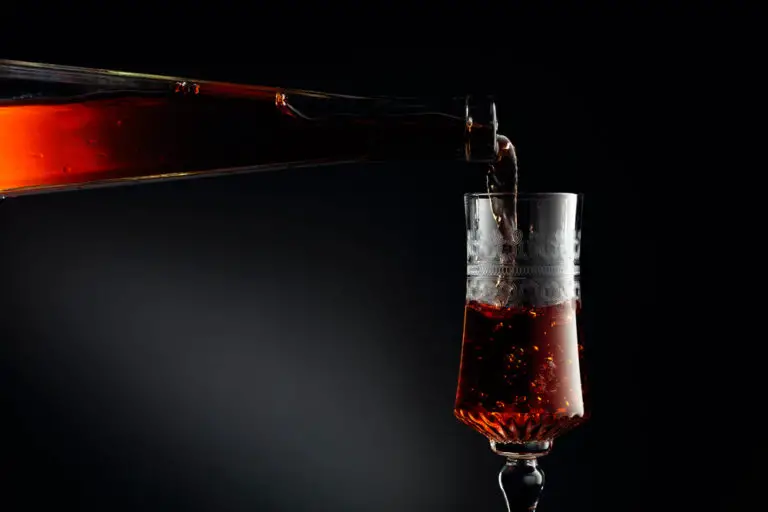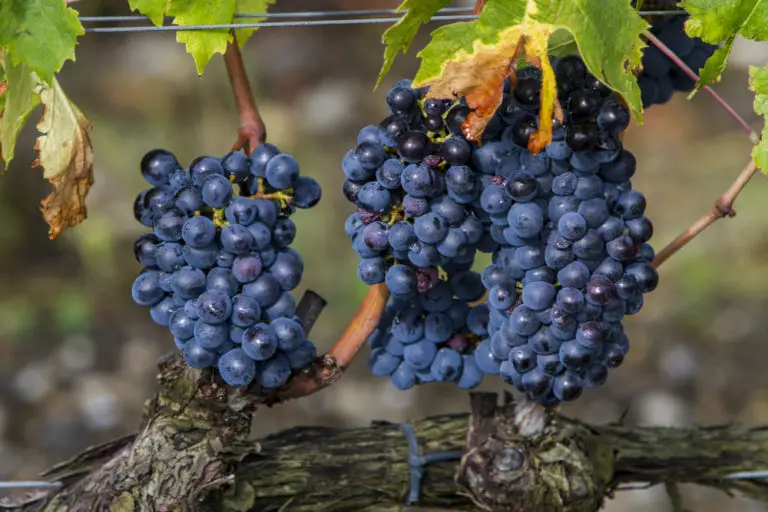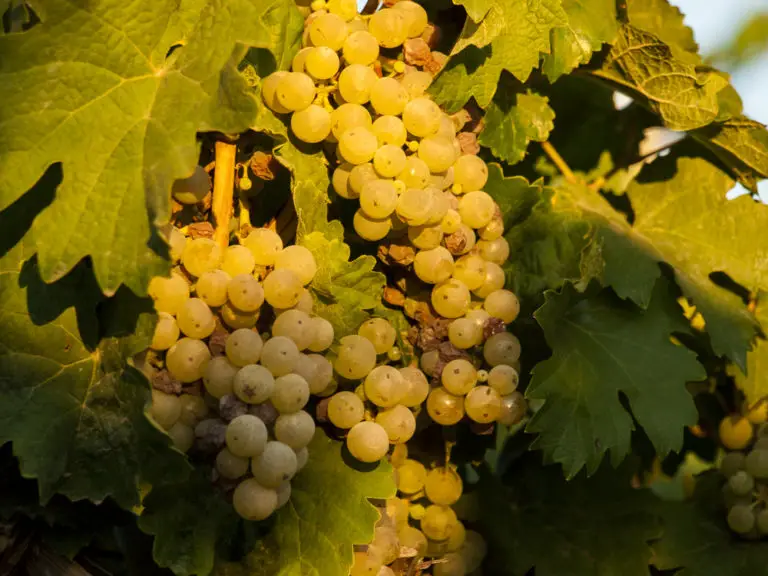Carignan: The Beginners Guide (2024)
Carignan is a high-yielding red grape variety that is widespread in the French Midi, Spain, Algeria, and California and produces wines of absolutely solid quality.
The Carignan vine began its triumphal march from Spain in the 12th century and became at home all over Europe.
Today Carignan can be found in growing areas with warm climates all over the world, for example, in California, Australia, South Africa, and South America.
Wine Color: Deep Dark Red Wine
Characteristics: Medium-body, Medium Tannin, Medium High acidity
Color of berry skin: White or Pink
Flavor: Dry
ABV: 13.5–15%
Origin: Spain, Cariñena
Notable Regions: Languedoc-Roussillon, Sardinia, Catalonia
Most Expensive Bottle: Domaine Les Mille Vignes Les Pied des Nymphettes
Common synonyms: Axina de Spagna, Babonenc, Babounenc, Blaue Shopatna.
- What is Carignan?
- Carignan Characteristics
- Known Regions for Carignan
- Popular Blends of Carignan
- How to Enjoy Carignan?
- How is Carignan Made?
- History of Carignan
- Alternatives for Carignan
What is Carignan?
The Carignan vine is large, conical to cylindrical, branched or shouldered, and with dense berries. The berries are round in shape, medium-sized, and black-blue. The skin of the vines is thick-skinned, and the flesh of the fruit is very juicy.
The grape variety ripens late, and since it shoots late, it is protected from damage caused by the late frost. It grows fast and has regular high yields. To guarantee high quality, the vine must be subject to strict vine training and yield regulation.
Strong winds or machine harvesting cause great difficulties for the cariñena grape variety, as its stems and wood are often riddled with cracks.
It is sensitive to powdery mildew and downy mildew, and raw rot when the weather is too humid. The red Carignan grape variety was created through mutations of Carignan Gris and Carignan Blanc. It has primary flavors of plums, sour cherries, cedarwood, eucalyptus, coffee, and other aromas.
Carignan vs. Grenache vs. Zinfandel
Carignan and Grenache are two red grape varietals that are often used together to make a blend. Carignan is a medium body wine while Grenache is medium-full bodied wine.
Both are fruit wines but have different flavors, Carignan flavor profile is dominant of Raspberry, dried Cranberry, baking spices, with a hint of licorice and cured meat. Grenache tasting notes are grilled plum, stewed strawberry, Blood orange, and dried herbs.
Carignan is a lighter body wine when compared with zinfandel. Zinfandel is a sweet-rose wine and is full-bodied. It has mostly floral notes, contrasting to Carignan, which has mostly fruity notes.
Most Zinfandels tend to be high in alcohol, ranging from 14%-17% ABV higher than carignan, which has 13.5–15% ABV.
Also, Zinfandel is very less acidic and its primary tastes are blackberry, strawberry, peach, cinnamon, and sweet tobacco, while Carignan has an additional spicy taste like that of tobacco leaves and baking spice.
Carignan Characteristics
With well-reduced yields, Carignan delivers first-class wines. Old vines, whose yield is naturally lower, are particularly suitable for this. In such cases, the wine is extremely dense and characterized by plums, sour cherries, cedarwood, eucalyptus, coffee, and other aromas.
However, the winemakers had to do extra work to overcome the naturally high tannins, acidity, and astringency and give the Carignan wine elegance and finesse. They were also forced to try different methods to make good Carignan varietal wines.
It has resulted in wines with a wide variety of Carignan flavors. For example, when winemakers use carbonated maceration, the wine has lower tannin levels and higher fruity notes.
If a winemaker matures the wine in light oak, you will taste vanilla and, in addition to the high acid content, even notice coconut in the bouquet. Carignan wines have sandalwood and baking spice notes when oiled.
Carignan Taste Profile
The Carignan wine color is dark, you can even call it a deep dark. A wealth of tannins, a wealth of tannins, and a wealth of acidity characterize this wine but lack aromas. Carignan Taste is beguiled with plum aromas, black cherries, lemon, exotic fruits, honey gingerbread, chili, caramel, spices, jam, and toasted notes.
So old vines deliver very good results. The wines were characterized with adjectives such as creamy, lively, tasty, fresh, full-bodied, dense, rich, gentle, generous, spacious, structured, mineral, earthy, and many more. The wines had a fine structure of tannins and were invited “to bite”.
On the nose, the Carignan profile often has subtle notes of violets, wild herbs, cinnamon, star anise spice, and cranberry sauce. Some Carignan wines are also more fruity, with delicious aromas of red fruits like strawberry, raspberry, and cranberry. It has medium to high acidity and is a medium body wine.
Carignan Ageability
The aging of the wine has the potential to improve the quality of the wine. It is what sets wine apart from most other consumer goods.
While wine can spoil and is perishable, complex chemical reactions with phenolic compounds (like tannins), sugar and acids can change the taste, mouthfeel, color, and aroma of the wine in ways that can be more convenient for the taster.
A wine’s ability to age is influenced by many factors like winemaking style, wine region, viticulture practices, Vintage, and grape variety. The condition in which the wine is kept after bottling can also influence the aging of wine and can be a considerable investment of money and time.
The aging of wine harbors great mysticism, as its chemistry has not been understood for a long time, and old wines are often sold at extraordinary prices.
However, the vast majority of wines are not aged, and even aged wine is seldom long-aged; It is estimated that 90% of the wine should be consumed within one year of manufacture, and 99% of the wine should be consumed within five years.
The best Carignan wine can age for ten years or more.
Notable Regions for Carignan
Carignan is grown across the world, and the major planting regions are France, Spain, and Italy.
It is also found in other regions of Europe like Israel, Turkey, Malta, Cyprus, and Croatia. It is also grown in African regions like Tunisia, Morocco, and South Africa. Let us take a look at this Carignan region in detail:
France
It is mostly found in the Southern France region, Carignan is mostly produced in Hérault, Gard, and Aude. It is sometimes made as Vin de pays and often made as Vin ordinaire wine. The plantations are mostly limited to warm Mediterranean climates as the gapes can not rip sufficiently in the damp maritime or continental climate.
Spain
These grapes can be mostly found in the Catalan wine region of Priorat. Some areas like the villages of Porrera and Poboleda in the Tarragona province have been growing grapes for over 100 years. This variety is also grown in other DOPs like Terra Alta, Tarragona, Penedès, Montsant, and Costers del Segre. These varieties are also called the Carinyena or Samsó in Catalan.
Other Old World regions
This grape varietal is popular in various parts of North Africa like Tunisia, Morocco, and Algeria. It played a vital role in the development of the Israeli wine industry. It is this country’s third most planted red grape variety. Other famous plantation areas are Turkey, Malta, Cyprus, and Croatia.
United States
According to the historical data, Carignan was one of the most planted grape varieties many years ago. Now, it is the third most widely planted grape variety produced here after a drop in production. It can also be found in the area of the central valley, in the Viticultural Areas in Sonoma, Mendocino, and Contra Costa counties where there is a slight increase in the planting. Outside California, it can be found in Missouri, Texas, and Washington State.
Popular Blends of Carignan
Carignan is one grape varietal that is often used to make blends. It has been known to produce some famous wines. You can usually find blends of Carignan in the stores near you, easily. Let us take a look at these Carignan blends in detail:
Bushong Same Deep Water As You Red
This wine is a blend of 17% Grenache, 33% Tempranillo, and 50% Carignan alcohol percentage. It has the aromas of pepper, boysenberry, and Toasty oak and is originally from Paso Robles, Central Coast, and California. The palate of this wine is inviting and broad, having enveloping flavors of blueberry compote, lilac, and boysenberry pie.
Neyers Sage Canyon Red
This bold and fruity blend of Syrah, Grenache, Mourvèdre, and Carignan alcohol content. It boasts fruity flavors of black currant, red cherry, and black cherry with fairly subtle toast and vanilla accents by aging in barrels. It has 13.6% alcohol and is produced in California.
Odfjell Aliara Organic Wine Red
This blend is well oaked and has ripe aromas of cassis and blackberry. It is a blend of Syrah, Cabernet Sauvignon, Malbec, and Carignan which makes a meaty and deep blend. It finishes with warm ripeness on the palate with the flavors of cassis, blackberry, herbs, tobacco, and black coffee,
Aperture Estate Vineyard Blend Red
This blend has a majority of Zinfandel varietal with a combination of others like Sémillon, Cabernet Franc, Carignan, Mourvèdre and Petite Sirah. It is of a fine blend from 1912-era vines. It is aged in large wooden barrels and is rich in complex red fruit flavors, rounded and soft.
Bodega de Edgar Tarragona Paper Street Vineyard Red
This blend with aromas of pepper dust, caramel, and crisp black raspberry on the nose adds a stony minerality and bright purple flowers to the blend. It is a blend of 23% Carignan abv, 23% Tempranillo and 54% Garnacha. It makes a rich wine that exhibits zesty freshness.
How to Enjoy Carignan?
Pairing up your red wine with the right kind of food, at the right serving temperature, and in the correct stemware can bring out the aromas and palate of wine at its best. Let us have a look at the ways to enjoy a glass of Carignan.
Food Pairings
Carignan is a bold red wine with fruity and earthy notes. It is ideal to be served with roasted pork, poultry dishes (duck, turkey), or even meaty beef brisket. The food should expand on its natural spice flavorings of dried herbs, star anise, 5-spice powder, cumin, and cinnamon. It will bring out the sweet and spicy flavors of the pairing. Some of the best combinations of Carignan food pairing are:
- Vegetable – Shitake Mushroom, Dried Cranberry, Wild Rice, Roasted Leek, Grilled Onion, Shallot, Garlic, Roasted Red Pepper, Eggplant, Tomato, Pumpkin, Kombucha Squash, Butternut Squash.
- Herb/Spice – Za’atar, Madras Curry, Ras El Hanout, Soy Sauce, Red Pepper Flake, Red Pepper Flake, Juniper Berry, Oregano, Thyme, Rosemary, Dill, Coriander, Cumin, Allspice, 5-Spice Powder, Clove, Cinnamon.
- Cheese – Yogurt, Farmer’s Cheese, Young Manchego, Basque Cheese, Parmesan, Gouda, and aged Gouda.
- Meat – Cured Meats (Soppressata, Bacon, Coppa, Bresaola), Lamb Gyros, Beef Brisket, Roasted Pork Shoulder, Chicken, Squab, Quail, Duck, Roast Turkey (dark meat).
Temperature
As we have already noticed, the old rule of thumb that red wine should be drunk at room temperature no longer applies or does not always apply. It is because nowadays we live in better-heated rooms and the red wine gets warmer as a result.
If you drink it too cold, it usually tastes more alcoholic and often bitter. If a glass of red wine is cooled down too far, this can result in it starting to taste oily and not being able to develop its taste properly.
The following temperatures are suitable for red wines:
- Very fruity and young red wines- 12 to14 degrees Celsius
- Light red wines- 14 to 16 degrees Celsius
- Medium-bodied red wines and everyday red wines- 16 to 18 degrees Celsius
- Powerful and heavy red wines- 18 degrees Celsius
Since Carignan is a bold wine, it should be ideally served at 15-20°C (60–68°F).
Stemware
There are two types of red glasses commonly known as Bordeaux glass and Burgundy glass, named after two famous wine-producing regions in France.
The glass for red Bordeaux wine must have a wide and long cup. This feature allows the connoisseur to make the drink travel around the edge of the glass until it reaches the mouth and be enjoyed. The model facilitates a greater concentration of its aromas.
Another highlight is that the red needs more space to breathe and exhale its striking aromas and flavors.
The Bordeaux glasses are ideal, for example, for wines more full-bodied (rich in tannins). The narrow rim directs the wine towards the tip of the tongue so you can feel the fruity flavors before the tannins are directed towards the back of the mouth.
Already Burgundy glasses come with a lower stem and bulge more rounded to enhance the area of oxygenation and allow the wine to breathe faster. Burgundy wines are known for being more complex and concentrated, especially labels produced with Pinot Noir.
It is for this characteristic that the glasses are produced with the so-called balloon shape, which favors the tasting of wine aromas. It directs the flow of the drink above the tip and center of the tongue to reduce acidity and accentuate the wine’s ripe qualities.
How is Carignan Made?
There are many factors in the making of red wine that produce its flavor variation. It is due to a large number of existing procedures to make it, which depends on the techniques that each winemaker selects. Let us take a look at the Carignan winemaking process:
Harvest
The grape harvest is carried out from the Carignan Vineyard at the appropriate point of ripening of the fruit, being vital for the final result of the wine. The harvest in Spain normally occurs between September and October, at which time the grape harvest is the protagonist.
Something to keep in mind during this stage is the level of sugar present in the grapes. This factor determines the level of Carignan alcohol and fermentation in the later stages of wine processing.
Destemming
The grapes are then separated from the rest of the bunch. This selection avoids adding more bitter flavors due to the presence of branches, leaves, or other debris. A method that is usually aimed at obtaining older wines with a more complex flavor.
Squeezed
After destemming, the grapes, already destemmed, are passed through a crushing machine. In this way, the aim is to break the skin of the fruit, which is called the skin, reaching the must that is inside. It is important during crushing not to exceed the force used, so as not to break the seeds of the fruit, which also provide that bitterness.
Maceration and fermentation
The maceration phase is necessary since the Carignan characteristics arise from it: color, structure, texture, etc. All this is possible due to the contact of the must with the skins. Thanks to the natural presence of yeast in the skins that promotes the fermentation process.
It is called alcoholic fermentation. It is called this way because during this phase the sugar in the fruit is transformed into ethyl alcohol. Its duration varies according to the type of wine but regularly varies between 10 and 14 days, controlling the temperatures, which should not exceed 29ºC.
Pressing
At the end of the maceration and fermentation, the so-called discovery takes place. That is the change of the liquid to another container where the fermentation is finished more slowly, thus obtaining the expected result.
Clarification
It is about eliminating the impurities present in this drink from the dragging of organic substances, reaching a filtration of the wine if necessary.
Bottling and storage
In bottling, the wine is stabilized, finding the aromas and properties of each production. In itself, the final product, whether it is stored in the bottle or the barrel, will vary according to the aging time. It is then ready to drink Carignan.
History of Carignan
Winemakers believe that the Carignan grapes came from a region northwest of Spain- Aragon- in the mid-15th century. The various synonyms and cultivation in wine regions of the old and new world are evidence of its long Carignan history.
Some believe that the Phoenicians spread the grape to different regions of their colonies. Unfortunately, the grape did not always have a good reputation for making fine wine.
In the 1970s, the Carignan grape became the most widely planted grape in France. Winemakers produced billions of liters of poor-quality Carignan wine. The importance of the grape and the problem of the French wine lake became an issue, and the authorities began an aggressive winemaking program.
Fortunately, some Carignan winemakers have started reinventing it, using the old vines to create rich, fruity wines that have revived the grape from its previous lows.
Alternatives for Carignan
Like most other wines, you can try some alternatives of Carignan if you want to try something similar. Zinfandel, Pinot noir, and Grenache are three wines that you can try if you want to taste something similar to drinking Carignan. Let us take a look at it in detail:
Zinfandel
Wines made from Zinfandel ink have an intense ruby color, with plum, raspberry, blackberry, and cherry on the palate standing out. Depending on the elaboration of the winemaking process, wines from the Zinfandel grape may present spicy notes, such as cinnamon and even vanilla, if stored in American oak barrels.
Pinot noir
Good Pinot Noir wines stand out for their elegance, finesse, and complexity, with wonderful and subtle aromas. It has a bouquet full of aromas and in the various subtleties and nuances that the wine is capable of offering. It has smooth tannins and great acidity, which makes it incredibly gastronomic.
Grenache
The Garnache variety is one of the great grapes in Spain and the South of France. It has aroma variations, such as raspberry, plum, strawberry, dried apricot, fresh black pepper, coffee, and leather, among others. Due to its high levels of sugar, wines originating from this variety are, in most cases, examples with a high alcoholic degree, which is why Garnacha is often used in wines.
FAQ
What do you eat with Carignan wine?
You will enjoy Carignan most when it is paired with food like meaty beef brisket, poultry dishes (duck, turkey), and roasted pork. Spices in these dishes enhance wine’s flavor.
How long to age Carignan wine?
Most wine should be consumed within one year of manufacture, and 99% of the wine should be consumed within five years. Best Carignan can age for 10 years or more.
Do you chill Carignan?
Carignan should be ideally served at 15-20°C. You can chill it in the fridge for about 30 minutes, then open the bottle and let it sit for 10 minutes.
What does Carignan taste like?
Carignan is a dry red wine having fruity and spicy flavors like cured meat, baking spices, tobacco leaf, raspberry, licorice, and dried cranberry.

